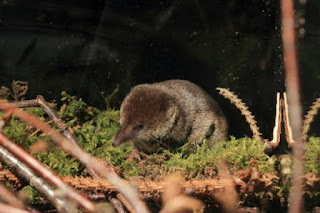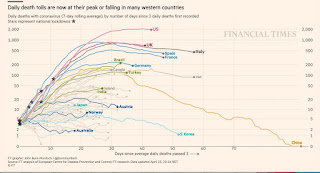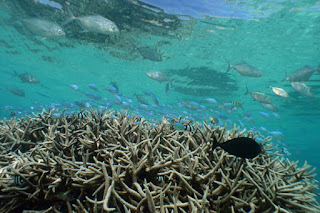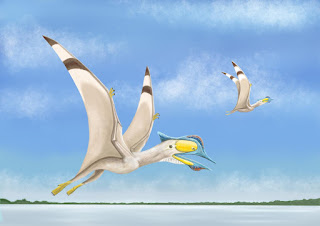I need a bit of clarity about the disaster unfolding here and when and why and who knew what.
For me personally it is easy to reconstruct - I was in Germany from 5.-14.3., where case numbers were three days ahead of the UK, and where media pay a lot more attention to what happens in other EU countries such as Italy, so I had a bit of a headstart in awareness. Around March 13th, when I heard the govt. advisors mentioning herd immunity, I did the back-of-the-envelope calculation. 66 million people x 60% infection rate needed for herd immunity x 1% mortality = 396,000 people dead unavoidably. Plus avoidable deaths of those who don't get access to a ventilator when they need one. Might be as many again, so could be anything up to 800,000.
It was a complete horror show to watch how it took the government another 10 days to realise that a six-figure number of casualties would look bad on all of their CVs, until they made a screeching U-turn. In these 10 days, infections went up by a factor of 10, and the deaths went up from 30 to 330. Based on China, I calculated that after lockdown, deaths still rise by two orders of magnitude (30 to 3000 in China's case). So my expectation for the UK is 33,000. We're well on track to reach this figure. Changing course 10 days earlier would have saved 90% of these, i.e. 30,000.
So, considering that it took me nothing more than two simple multiplications to realise the govt was driving us over a cliff, I am really curious about who knew what and what they are going to say in their defence when they end up in court for killing 30,000 people by gross negligence. Based on my own notes from the events of the past weeks, and on today's comprehensive reports in the Sunday Times (
paywalled but there are copies floating around on social media) and in the Observer, I've drawn up a simple timeline of how we got into this mess.
covid-19 timeline
2016 Pandemic preparation exercise Cygnus finds health system would collapse, naming many key problems including shortage of ventilators and PPE. Recommendations resulting from the analyses were never implemented.
31.12.2019 China alerts WHO that several cases of an unusual pneumonia had been recorded in Wuhan.
22.1.2020 WHO begins daily briefings on new coronavirus disease
UK government convenes first meeting of its scientific advisory group for emergencies (Sage) to discuss the virus
24.1. Chinese experts report in the Lancet new coronavirus disease with 800 confirmed cases and confirmed human-to-human transmission.
First Cobra meeting considering the virus happens without Johnson, chaired by Hancock who says risk to UK is low.
29.1. First cases identified on British soil: two Chinese nationals in York.
30.1. UK govt. raises risk from low to moderate. WHO raises highest level of alert.
31.1. Johnson speech on Brexit Day.
3.2. Johnson speech at Greenwich: “There’s a risk that new diseases such as coronavirus will trigger a panic and a desire for market segregation that go beyond what is medically rational to the point of doing real and unnecessary economic damage.”
”Humanity needs some government somewhere that is willing at least to make the case powerfully for freedom of exchange, some country ready to take off its Clark Kent spectacles and leap into the phone booth and emerge with its cloak flowing as the supercharged champion of the right of the populations of the Earth to buy and sell freely among each other.”
7.2. Chinese doctor reprimanded for his early warnings dies of the disease. His death is also reported in the UK.
13.2. Cabinet reshuffle. Matt Hancock remains health secretary.
Johnson goes on 2-week half-term holiday at Chevening.
19.2. Champions League match Atalanta Bergamo v Valencia at Bergamo acts as a major spreading event, setting up new hotspots of infection in Valencia as well.
21.2. Italy imposes lockdown on many northern cities
25.2. Johnson returns to London for fundraising event, the Winter Party.
26.2. John Edmunds and colleagues present a scenario to govt. advisors that predicts 380,000 deaths and need for 220,000 intensive care beds. Their report emphasised the urgent need for a lockdown.
29.2. Johnson and Symonds at Chequers, release baby news.
1.3. Meeting of Sage, Dept. Health and NHS sees evidence from Italy suggesting 8% of people infected will need hospital treatment (up from 4-5%), raising concern re NHS ability to cope.
2.3. First Cobra meeting on coronavirus attended by Johnson, after he missed the previous five. Battle plan drawn up including plans to establish Nightingale field hospitals.
3.3. Johnson says he still shakes hands with everybody, including Covid-19 patients.
7.3. Johnson attends Rugby match at Twickenham.
9.3. Italy extends lockdown to the whole country.
10.-13.3. Cheltenham Festival goes ahead with 250,000 visitors, encouraged by govt.
11.3. WHO declares global pandemic.
Champions League game Atletico Madrid v Liverpool goes ahead in Liverpool and 3000 Atletico fans attend although Spain is already beginning lockdown measures.
12.3. Johnson at press conference: “More families, many more families, are going to lose loved ones before their time.”
13.3. UK govt. moves from contain to delay phase – emphasizing hygiene measures, but giving up contact tracing and systematic testing. Patrick Vallance, the govt. chief scientific advisor discusses herd immunity as part of the government's strategy.
18.3. School closures announced. Last day of school: Fri 20.3. ?
Pubs and restaurants also to close at the end of business on 20.3.
23.3. UK govt announces stay at home order for following day. Official hospital deaths announced by that day: 335, with more than 20% daily increases, tracking Italy’s curve with 2 weeks delay.
1.4. According to Doris Ann Williams, ceo of British In Vitro Diagnostics Association cited in the Sunday Times, this was the date her organisation was first approached by the govt. to help scale-up of testing.
The British Healthcare Trades Association (BHTA) was ready to help supply PPE in February — and throughout March — but it was only on April 1 that its offer of help was accepted.

This illustration shows the ultrastructural morphology of the novel coronavirus responsible for the 2019–2020 pandemic of the COVID-19 coronavirus disease. (Photo: Alissa Eckert, MS, Dan Higgins, MAM.)
PS after writing this it occurred to me that March 21st was the 100th day after the election. Is this the worst 100-day record of any government ever?
Some links:
Polly Toynbee's analysis on the situation after the Sunday Times report.
UPDATE 5.5.2020:
The
Guardian has published an extensive report with a timeline on 30.4. From this I learned that the Chief Medical Officer, Chris Whitty, said on March 3rd (at the press conference where Johnson said he was shaking hands with everybody) that in a worst case scenario 80% of the population could become infected and 1 % might die. Nobody seems to have done the multiplication which would have shown a result of 528,000 deaths (still not including those to the health system collapsing under the overload).
Also from the Guardian report, a couple of quotes from Patrick Vallance, 13.3.: “Our aim is to try and reduce the peak, broaden the peak, not suppress it completely,” Vallance explained on BBC Radio 4’s Today programme: “Also, because the vast majority of people get a mild illness, to build up some kind of herd immunity, so more people are immune to this disease, and we reduce the transmission. At the same time, we protect those who are most vulnerable to it. Those are the key things we need to do.”
Asked on Sky News what proportion of the population would need to become infected to achieve herd immunity, Vallance replied: “Probably about 60% or so.”










































